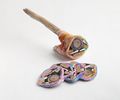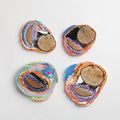Difference between revisions of "Cold Cuts Coasters"
| Line 1: | Line 1: | ||
{{Infobox|1=[[File:CK-Cold_Cuts_2011_1.jpg|200px]]|2=Cold Cuts Coasters |3=2011 |4=urethane resin, wood, spandex, epoxy clay, rope and various other materials |5= studio made}} | {{Infobox|1=[[File:CK-Cold_Cuts_2011_1.jpg|200px]]|2=Cold Cuts Coasters |3=2011 |4=urethane resin, wood, spandex, epoxy clay, rope and various other materials |5= studio made}} | ||
'''Cold Cuts Coasters''' are the first collaborative work made by [[Chen Chen]] and [[Kai Williams]]. The inspiration came from standing in line at the deli counter watching the meat get sliced. The original goal was to create a bracelet that could be cut to width at the point of sale based on the specifications of the customer. | '''Cold Cuts Coasters''' are the first collaborative work made by [[Chen Chen]] and [[Kai Williams]]. The inspiration came from standing in line at the deli counter watching the meat get sliced. The original goal was to create a bracelet that could be cut to width at the point of sale based on the specifications of the customer. This was abandoned as the process was too messy. | ||
This is the first composite material that the studio produced and although marketed and sold as coasters, they are more of a study in combining various materials. | |||
<gallery> | |||
File:CK-Cold_Cuts_2011_4.jpg | |||
File:CK-Cold_Cuts_2012_2.jpg | |||
File:CK-Cold_Cuts_2012_5.jpg | |||
File:CK-Cold_Cuts_2012_6.jpg | |||
File:CK-Cold_Cuts_2015_2.jpg | |||
{...} | |||
</gallery> | |||
==Production== | |||
Spandex netting, which was around the studio from the production of [[Swell Vase]]s, is dipped in urethane resin and wrapped around a core made of wood and various other materials. The large surface area of the netting allows the resin to impregnate the material faster and more evenly than a solid fabric. Once the resin cures and the netting is hardened, the resulting log is sliced on a chop saw. | |||
The process generates random compositions as although the maker can compose it to a degree, the final result cannot be fully predicted and is only reveled when cut open. | |||
<gallery> | <gallery> | ||
| Line 11: | Line 27: | ||
{...} | {...} | ||
</gallery> | </gallery> | ||
==Finishes== | |||
Original batches of the coasters were finished with a clear acrylic spray. As this finish was not designed for application on resin hardened fabrics, sometimes a sticky residue would form. | |||
Since 2012 the coasters are finished with 3 coats of West Systems marine epoxy and polished to a semigloss surface. | |||
Revision as of 19:52, 6 June 2018
Cold Cuts Coasters are the first collaborative work made by Chen Chen and Kai Williams. The inspiration came from standing in line at the deli counter watching the meat get sliced. The original goal was to create a bracelet that could be cut to width at the point of sale based on the specifications of the customer. This was abandoned as the process was too messy.
This is the first composite material that the studio produced and although marketed and sold as coasters, they are more of a study in combining various materials.
Production
Spandex netting, which was around the studio from the production of Swell Vases, is dipped in urethane resin and wrapped around a core made of wood and various other materials. The large surface area of the netting allows the resin to impregnate the material faster and more evenly than a solid fabric. Once the resin cures and the netting is hardened, the resulting log is sliced on a chop saw.
The process generates random compositions as although the maker can compose it to a degree, the final result cannot be fully predicted and is only reveled when cut open.
Finishes
Original batches of the coasters were finished with a clear acrylic spray. As this finish was not designed for application on resin hardened fabrics, sometimes a sticky residue would form.
Since 2012 the coasters are finished with 3 coats of West Systems marine epoxy and polished to a semigloss surface.




